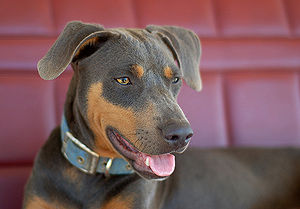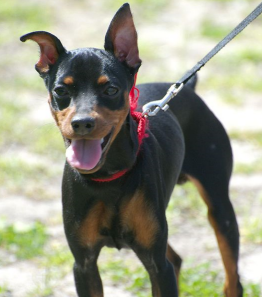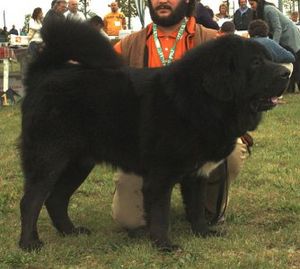 |
| Vital Statistics: |
| Place of Origin: United States |
| Group: Herding |
| Height: 17-23 in. |
| Weight: 30-50 lbs. |
| Life span: 16 years and more |
| Trainability: high |
| Good with children: yes, with supervision of young ones |
| Good with other pets: may view small animals as prey |
What is the origin of the Blue Lacy?
Uniquely Texan, the Blue Lacy was developed in the 1800s by 4 brothers, Ewin, Harry, George and Frank Lacy. The spirited pioneer Lacys moved to Texas from Kentucky in 1858. Lacys are working dogs and favorites with ranchers, cowboys and hunters. Lacys are working dogs bred to gather feral hogs. Texas adopted the Blue Lacy as its state dog in 2005.
What does the Blue Lacy look like?
Lacys are medium size with powerful builds. Height is 17-23 inches and weight can be from 30-50 lbs. Eye color is yellow to amber. Ears are pendant. The coat is short, smooth and lies close to the body. Coat color is primarily ranges of solid blue or red with a white chest or tricolor with a blue base, red markings over eyes, muzzle, down legs and under tail. Coat requires minimal brushing.
What is the temperament of the Blue Lacy?
Lacys are highly intelligent and easily trained to perform many tasks. As with all dogs, early positive training and socialization is necessary. Lacys are sensitive to loud voices, so commands should not be yelled. This energetic breed loves children but should be supervised when with them. Since they herd and hunt, they may view small animals as prey. Lacys require daily vigorous exercise and work. While they can live in apartments, without enough exercise, there can be problems.
What is the Blue Lacy used for?
Lacys love to work and are excellent cattle herders and hunters. They excel at tracking, agility, flyball and are good watchdogs. Lacys are wonderful companions for people who can see to their needs.
Possible Health Issues
Skin and coat problems (alopecia), food allergies
- Australian Cattle Dog
- Australian Kelpie
- Australian Shepherd
- Bearded Collie
- Beauceron
- Belgian Sheepdog – Groenendael
- Belgian Tervuren
- Bergamasco
- Berger Picard
- Border Collie
- Bouvier des Flandres
- Briard
- Cardigan Welsh Corgi
- Catahoula Leopard Dog
- Collie
- English Shepherd
- Entlebucher
- Finnish Lapphund
- German Shepherd
- Hovawart
- Icelandic Sheepdog
- Laika
- Lancashire Heeler
- Miniature American Shepherd
- Mudi
- Old English Sheepdog
- Pembroke Welsh Corgi
- Polish Lowland Sheepdog
- Puli
- Pumi
- Pyrenean Shepherd
- Shetland Sheepdog
- Standard Schnauzer
- Swedish Vallhund
- Alaskan Klee Kai
- Alaskan Malamute
- American Cocker Spaniel
- American Eskimo Dog
- American Foxhound
- American Pit Bull Terrier
- American Stratfordshire Terrier
- Australian Shepherd
- Bichpoo
- Black and Tan Coonhound
- Boston Terrier
- Boykin Spaniel
- Carolina Dog
- Catahoula Leopard Dog
- Chesapeake Bay Retriever
- Chinook
- English Shepherd
- Maltipoo
- Mi Ki
- Miniature American Shepherd
- Mountain Cur
- Plott Hound
- Rat Terrier
- Redbone Coonhound
- Redtick Coonhound
- Silken Windhound
- Toy Fox Terrier
- Treeing Tennessee Brindle



